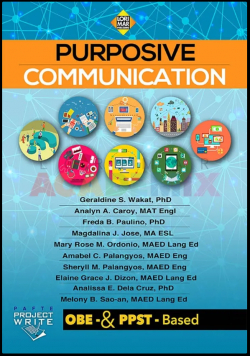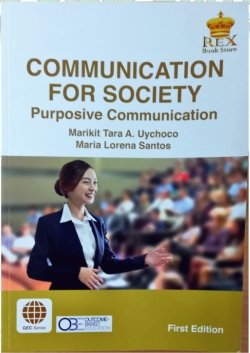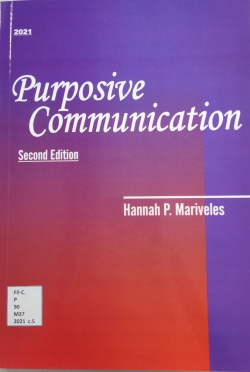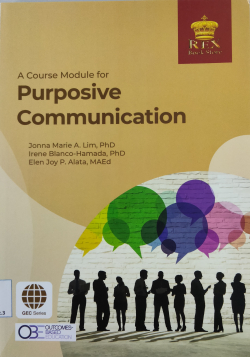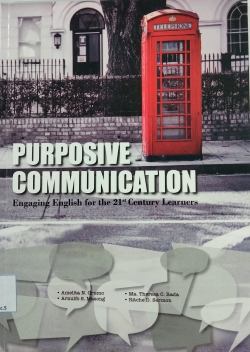Purposive communication

Buy online ($)
Type
Book
ISBN 13
9786214091416
Category
Filipiniana-Circ.
[ Browse Items ]
Publication Year
2019
Publisher
Books Atbp. Publishing Corp., Philippines
Pages
x, 246 p. : ill.
Subject
1. Purposive communication. 2. Communication.
Tags
Abstract
The textbook Purposive Communication has been written and published as a response to the exigent need for college or university courses which are relevant to the skills of the 21st century learners. As contained in the Commission on Higher Education (CHED) Memorandum Order No. 20, s2013 and as part of the New General Education Curriculum, Purposive Communication is a course about writing, speaking, and presenting to different audiences and for various purposes.
In the above-mentioned memorandum, Purposive Communication is further described as "a three-unit course that develops students' communicative competence and enhances their cultural and intercultural awareness through multimodal tasks that provide them opportunities for communicating effectively and appropriately to a multicultural audience in a local or global context. It equips students with tools for critical evaluation of a variety of texts and focuses on the power of language and the impact of images to emphasize the importance of conveying messages responsibly. The knowledge, skills, and insights that students gain from this course may be used in their other academic endeavors, their chosen disciplines, and their future careers as they compose and produce relevant oral, written, audio-visual and/or web-based output for various purposes" (CMO No. 20, s2013).
Divided into three major areas, the intended learning outcomes of Purposive Communication include the following:
Knowledge
1. Describe the nature, elements, and functions of verbal and nonverbal communication in various and multicultural contexts;
2. Explain how cultural and global issues affect communication;
3. Determine culturally appropriate terms, expressions, and images;
4. Evaluate multimodal texts critically to enhance receptive (listening, reading, viewing) skills; and
5. Summarize the principles of academic text structure.
Skills
1. Convey ideas through oral, audio-visual, and/pr web-based presentations for different target audience in local and global settings using appropriate registers;
2. Create clear, coherent, and effective communication materials;
3. Present ideas persuasively using appropriate language registers, tone, facial expressions, and gestures; and
4. Write and present academic papers using appropriate tone, style, conventions, and reference styles.
Values
1. Adopt cultural and intercultural awareness and sensitivity in communication of ideas;
2. Appreciate the differences of the varieties of spoken and written language;
3. Adopt awareness of audience an context in presenting ideas; and
4. Appreciate the impact of communication on society and the world.
In order to accomplish these objectives, this Purposive Communication textbook contains materials that the authors have designed to further enhance not only the knowledge and understanding of the learners but also their higher order thinking skills that include analysis, application, evaluation and creation.
Relative to this, four general areas of discussion have been included in this textbook:
Unit 1- Communication Processes, Principles and Ethics
Communication and Globalization
Unit 2- Varieties and Registers of Spoken and Written languages
Evaluating Messages and Images of Different Types of texts Reflecting Different Cultures
Unit 3- Communication Aids And Strategies Using Tools of Technology
Communication for Various Purposes
Unit 4- Communication for Work Purposes
Communication for Academic Purposes
each of the lessons under these units contains seven components from vocabulary enhancement to deepening of learning through the HOTS - application, analysis, evaluation, and creation.
With the current emphasis on Outcome-Based Education (OBE) in the curriculum of higher educational institutions in the Philippines, the last part of this textbook is an OBE Multimodal Public Awareness Campaign (MPAC) project through print, i.e. brochure and poster, oral and audio-visual presentations. This final requirement is an effective and efficient way of assessing students' knowledge and skills vis-a-vis the course intended learning outcomes, learning-teaching strategies and assessment strategies in an OBE curriculum.
Finally, this textbook validates the essence of 21st century learning that emphasizes not only on learners gaining units of knowledge but also on acquiring new set of competencies inorder to effectively use the knowledge they gain.
In the above-mentioned memorandum, Purposive Communication is further described as "a three-unit course that develops students' communicative competence and enhances their cultural and intercultural awareness through multimodal tasks that provide them opportunities for communicating effectively and appropriately to a multicultural audience in a local or global context. It equips students with tools for critical evaluation of a variety of texts and focuses on the power of language and the impact of images to emphasize the importance of conveying messages responsibly. The knowledge, skills, and insights that students gain from this course may be used in their other academic endeavors, their chosen disciplines, and their future careers as they compose and produce relevant oral, written, audio-visual and/or web-based output for various purposes" (CMO No. 20, s2013).
Divided into three major areas, the intended learning outcomes of Purposive Communication include the following:
Knowledge
1. Describe the nature, elements, and functions of verbal and nonverbal communication in various and multicultural contexts;
2. Explain how cultural and global issues affect communication;
3. Determine culturally appropriate terms, expressions, and images;
4. Evaluate multimodal texts critically to enhance receptive (listening, reading, viewing) skills; and
5. Summarize the principles of academic text structure.
Skills
1. Convey ideas through oral, audio-visual, and/pr web-based presentations for different target audience in local and global settings using appropriate registers;
2. Create clear, coherent, and effective communication materials;
3. Present ideas persuasively using appropriate language registers, tone, facial expressions, and gestures; and
4. Write and present academic papers using appropriate tone, style, conventions, and reference styles.
Values
1. Adopt cultural and intercultural awareness and sensitivity in communication of ideas;
2. Appreciate the differences of the varieties of spoken and written language;
3. Adopt awareness of audience an context in presenting ideas; and
4. Appreciate the impact of communication on society and the world.
In order to accomplish these objectives, this Purposive Communication textbook contains materials that the authors have designed to further enhance not only the knowledge and understanding of the learners but also their higher order thinking skills that include analysis, application, evaluation and creation.
Relative to this, four general areas of discussion have been included in this textbook:
Unit 1- Communication Processes, Principles and Ethics
Communication and Globalization
Unit 2- Varieties and Registers of Spoken and Written languages
Evaluating Messages and Images of Different Types of texts Reflecting Different Cultures
Unit 3- Communication Aids And Strategies Using Tools of Technology
Communication for Various Purposes
Unit 4- Communication for Work Purposes
Communication for Academic Purposes
each of the lessons under these units contains seven components from vocabulary enhancement to deepening of learning through the HOTS - application, analysis, evaluation, and creation.
With the current emphasis on Outcome-Based Education (OBE) in the curriculum of higher educational institutions in the Philippines, the last part of this textbook is an OBE Multimodal Public Awareness Campaign (MPAC) project through print, i.e. brochure and poster, oral and audio-visual presentations. This final requirement is an effective and efficient way of assessing students' knowledge and skills vis-a-vis the course intended learning outcomes, learning-teaching strategies and assessment strategies in an OBE curriculum.
Finally, this textbook validates the essence of 21st century learning that emphasizes not only on learners gaining units of knowledge but also on acquiring new set of competencies inorder to effectively use the knowledge they gain.
Description
Contents:
Unit 1- Communication Processes, Principles and Ethics
Communication and Globalization
Unit 2- Varieties and Registers of Spoken and Written languages
Evaluating Messages and Images of Different Types of texts Reflecting Different Cultures
Unit 3- Communication Aids And Strategies Using Tools of Technology
Communication for Various Purposes
Unit 4- Communication for Work Purposes
Communication for Academic Purposes
Unit 1- Communication Processes, Principles and Ethics
Communication and Globalization
Unit 2- Varieties and Registers of Spoken and Written languages
Evaluating Messages and Images of Different Types of texts Reflecting Different Cultures
Unit 3- Communication Aids And Strategies Using Tools of Technology
Communication for Various Purposes
Unit 4- Communication for Work Purposes
Communication for Academic Purposes
Biblio Notes
Notes:
Includes bibliographical references.
Includes bibliographical references.
Number of Copies
5
| Library | Accession No | Call No | Copy No | Edition | Location | Availability |
|---|---|---|---|---|---|---|
| Main | 472 |
Fil-C. P90 C38 2019 |
1 | Filipiniana Section | Yes | |
| Main | 473 |
Fil-C. P90 C38 2019 |
2 | Filipiniana Section | Yes | |
| Main | 474 |
Fil-C. P90 C38 2019 |
3 | Filipiniana Section | Yes | |
| Main | 475 |
Fil-C. P90 C38 2019 |
4 | Filipiniana Section | Yes | |
| Main | 476 |
Fil-C. P90 C38 2019 |
5 | Reserve Section | Yes |
